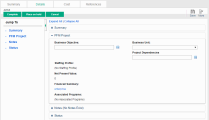Planning a Project
This section lists the tasks of planning a project before starting and executing it.
In this topic:
- Creating a Project
- Adjusting Project Settings
- Defining Project Participants
- Entering Project Details
- Associating the Project to Business Objective or Strategic Theme
- Drafting a Work Plan
- Creating a Staffing Profile
Creating a Project
You can create a project either from scratch or from a proposal.
Adjusting Project Settings
Project settings are inherited from the project policies which are dictated by the chosen project type. When a policy is overridable, project managers can edit a policy in the project settings to suit the project's objectives.
To view or edit project settings, click ... > Project Settings in the upper-right corner of the Project Overview page. For details of each policy, see:
- Project Fields Policy
- Work Plan Policy
- Request Types Policy
- Scheduling policy
- Schedule Health policy
- Cost and effort policy
- Cost and Earned Value Health Policy
- Project scheduling integration
- Staffing Profile Assignments Policy
- Project Health policy
- Issue Health Policy
- Task Auditing Policy
- Project Overview Layout policy
- Project Security Policy
- Service Manager Policy
- Project Formula Policy
- Hybrid Project Policy
Note: When you save project settings, PPM by default calculates the staffing profile labor cost. If your project has a large staffing profile that contains more than 200 positions, or it takes more than 2 minutes to save project settings, you should set the parameter ENABLE_SP_LABOR_COST_UPDATE to false in the server.conf file, so that PPM will not calculate the staffing profile labor cost when you save project settings.
Defining Project Participants
In general, Project Management classifies project participants in a project into 5 groups.
| Participant | Description |
|---|---|
| Project managers | Project managers take part in project planning and management, overseeing project execution, issue resolution, and budgetary concerns. |
| Stakeholders | Stakeholders are users who do not perform any work on a project, but are interested in the project's status and need to view project progress. |
| Resources |
Resources are users who work on tasks as part of a project team, but do not have the administrative responsibilities of a project manager. Resources view and update their tasks in Project Management. Resource listed in this group include:
|
|
Summary Task Owners |
Summary task owners are the people named on summary tasks who have oversight over that section of the work plan. Note: If you set a large number of resources as the summary task owners, the length of |
| Program Managers | If the project belongs to a program, this group lists the program managers. |
Add additional project managers and stakeholders for a project
- Open the project.
-
In the upper-right corner of the Project Overview page, click ... > Configure Participants.
-
Add additional project managers or stakeholders.
-
Click Add Project Manager to add one or more project managers.
-
Click Add Stakeholder and select Add User or Add Security Group to add new stakeholders.
Note: The individual users and users in the security groups are listed by user ID in the database in the following form:
<user_id>#@#<user_id>#@#<user_id>#@#<user_id>The maximum length of the variable that holds the delimited list of user IDs is
4,000.The maximum number of stakeholders of a project depends on the character length of user IDs. The longer the user IDs are, the less stakeholders can be supported. For example, if all user IDs have five digits, then the project can have 4000/8=500 stakeholders, with the delimiter "#@#" taken into calculation.
-
-
Click Done.
Entering Project Details
The Details tab of the Project Overview page contains fields that hold important project information, such as the business unit responsible for the project, or the business objectives the project is designed to fulfill.
- These fields are determined by the request type that is associated with the project type where the project belongs as the project process request type.
- You update these fields and move the project through the steps of the workflow associated with the request type.
Align project to strategic theme
If your project is included in a portfolio that has defined strategic themes, in the Strategy section, align the project to one strategic theme that is applicable.
KPIs related to the business goals that serve the selected strategic theme are listed as relative KPIs. During the project execution, you may need to forecast how much impact your project would make to these KPIs. For details, see Forecast project contributions to KPIs.
Associating the Project to Business Objective or Strategic Theme
You use either business objectives or strategic themes to track what value the project is going to deliver.
| To associate the project to a strategic them |
|
| To associate the project to business objectives |
|
Drafting a Work Plan
The work plan is the project's hierarchical structure of tasks that logically groups, organizes, and schedules activities and deliverables.
Drafting a work plan involves the following tasks:
Creating a Staffing Profile
Staffing profiles enable a project manager to track the demand of resources for a project, arranged by role or skill. A staffing profile can be created for a project to tie it to business functions and facilitate meaningful comparison visualizations.
To create a staffing profile for a project, click Create a Blank Staffing Profile in the Project Overview page > Summary tab > Staffing portlet.
For details on creating staffing profiles and making use of staffing profile functionality, see the Resource Management User’s Guide.
 Next steps:
Next steps:












